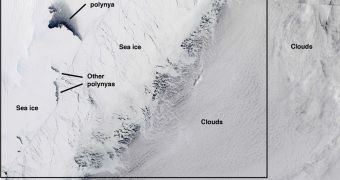An international group of researchers led by experts at NASA was recently able to find an interesting new link between the level of salt in the South Ocean and the speed at which an important glacier in Antarctica flows into the water. The discovery helps explain a phenomenon that scientists first observed some years ago.
The research was centered on the Totten Glacier, which is located in East Antarctica. This formation is well known among climatologists, because it releases vast volumes of ice into the ocean, sufficient to fill Lake Erie once every week. Interesting, glaciers around it flow much slower into the sea.
The purpose of the study was, therefore, to investigate the local mechanisms that enabled Totten to move so fast. As a general rule, Antarctic glaciers tend to flow faster downhill overall, due to increased global temperatures, but localized variations exist that need to be explained with additional data.
Researchers discovered that the key to explaining Totten Glacier's behavior was brine, or extra salty water. The stuff was found to accumulate in small openings that sometimes appear in sea ice. The brine was found to promote increased glacier speeds through a host of processes.
Conclusions extracted from studies such as these are very important for climate sciences, because they help inform and refine models of how global sea levels will increase over the next few decades.
Researcher Ala Khazender, who is based at the NASA Jet Propulsion Laboratory, Pasadena, California, was the lead author of the new research. “I was curious why Totten was changing so fast when the glacier just next to it wasn't changing much,” he says.
Details of the investigation appear online, in the December 5 issue of the top scientific journal Nature Communications. The team used data from ocean numerical models and the ICESat-1 satellite to survey Totten Glacier from multiple perspectives.
The research shows that large, recurring openings in sea ices called polynyas play an important role in accelerating both the flow speed and thinning of this glacier. Inside these annual openings in the ices, water that freezes back leaves behind its salt content. This leads to the formation of brine.
Since saltier water is heavier, it tends to sink to the bottom of the ocean, where it enters tiny crevices beneath the glacier. This process would prevent the glacier flowing too fast. Alternatively, if insufficient brine is produced, then the ice fields would accelerate considerably.
During winters that feature reduced polynya extents, Totten Glacier flows much faster, since warm water replaces brine under the ice masses, favoring their rapid advancement.
“If that happens, the glacier's flow could be significantly destabilized, causing it to discharge even more ice into the ocean. With the widespread changes seen in Antarctic sea ice conditions over the last few years, this process could be affecting other glaciers around Antarctica and the volume of ice they discharge into the ocean,” Khazender adds.
The research team also included scientists from the University of California in Los Angeles (UCLA), the University of California in Irvine (UCI), and the Utrecht University, in the Netherlands.

 14 DAY TRIAL //
14 DAY TRIAL //